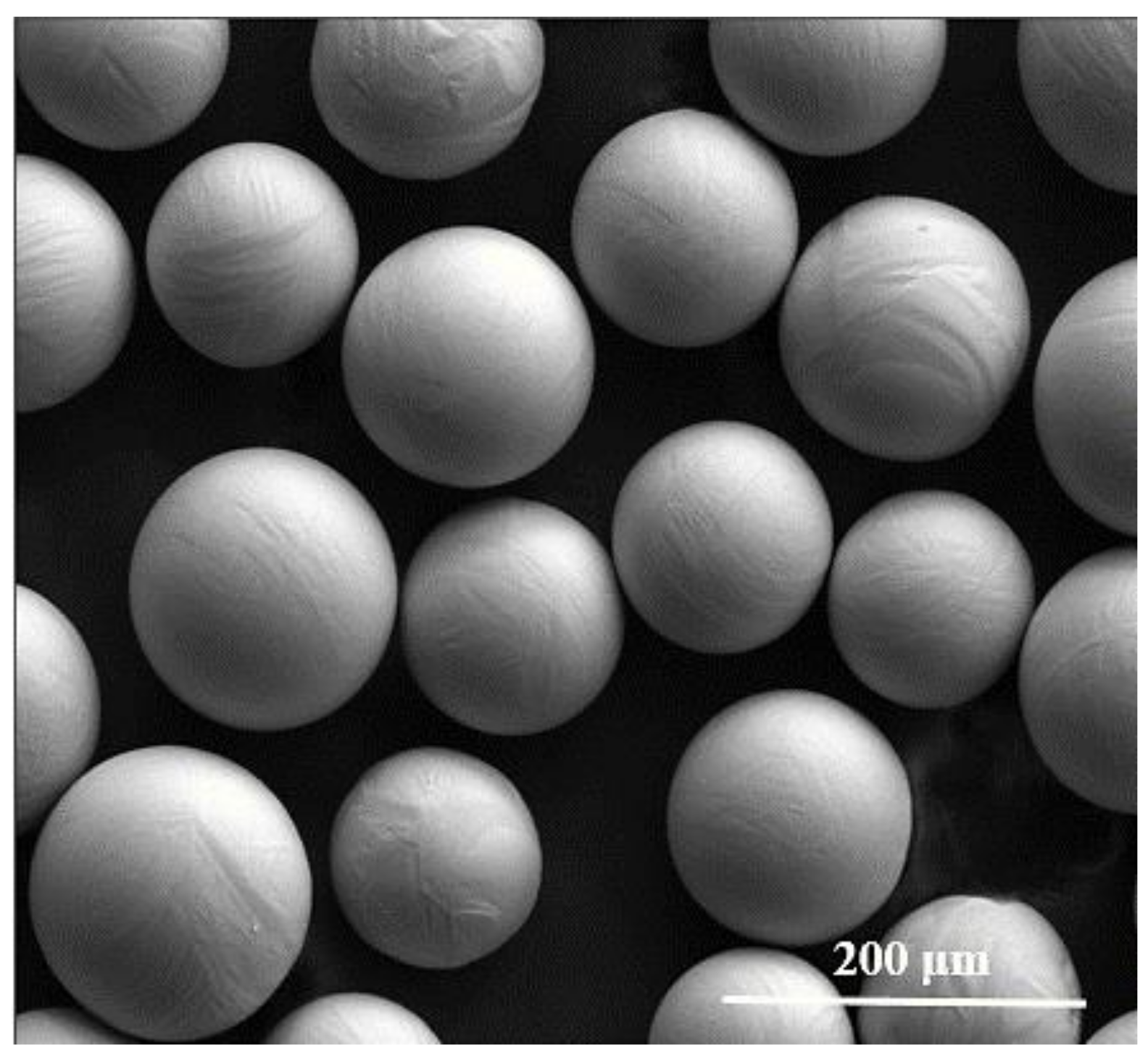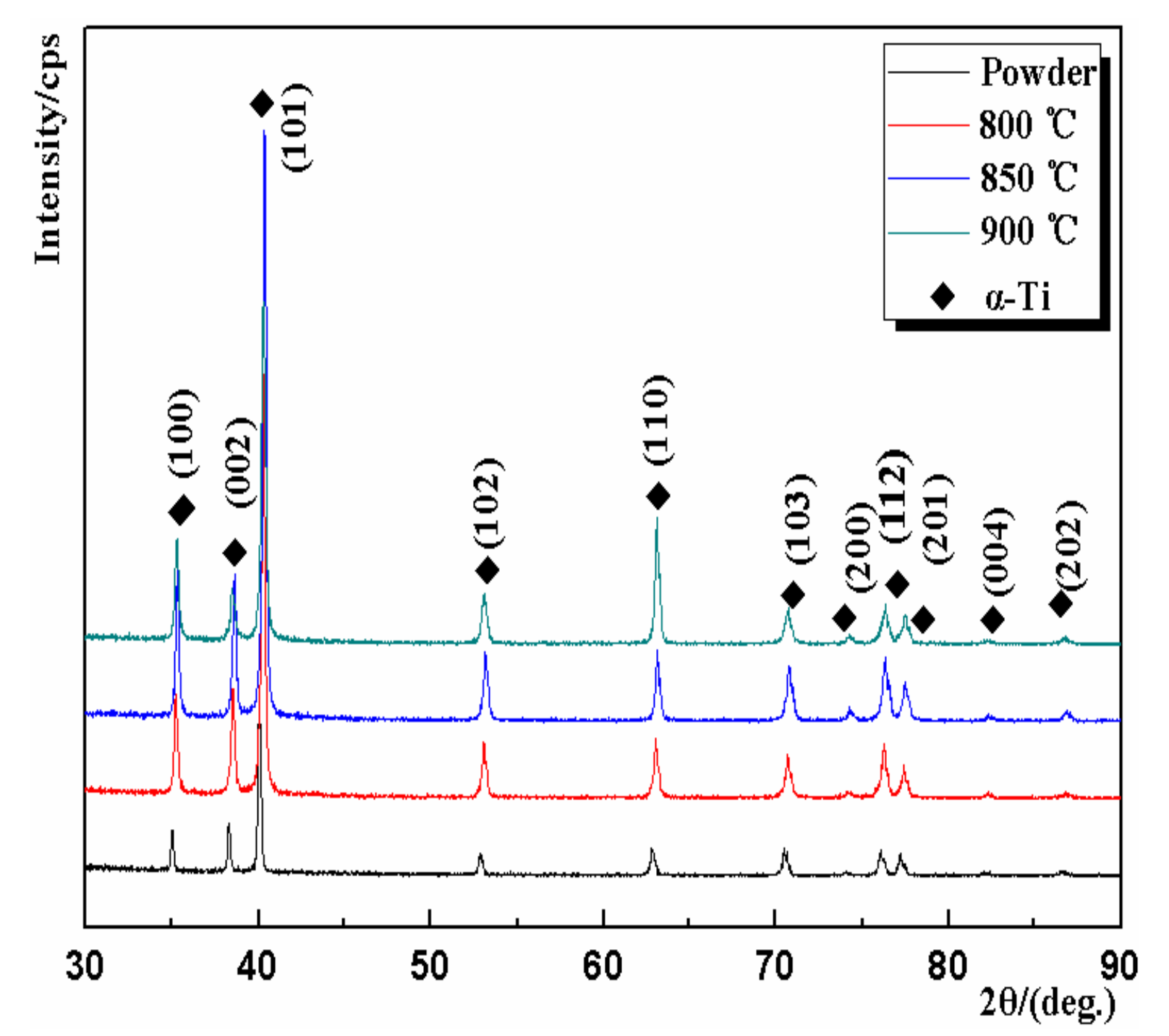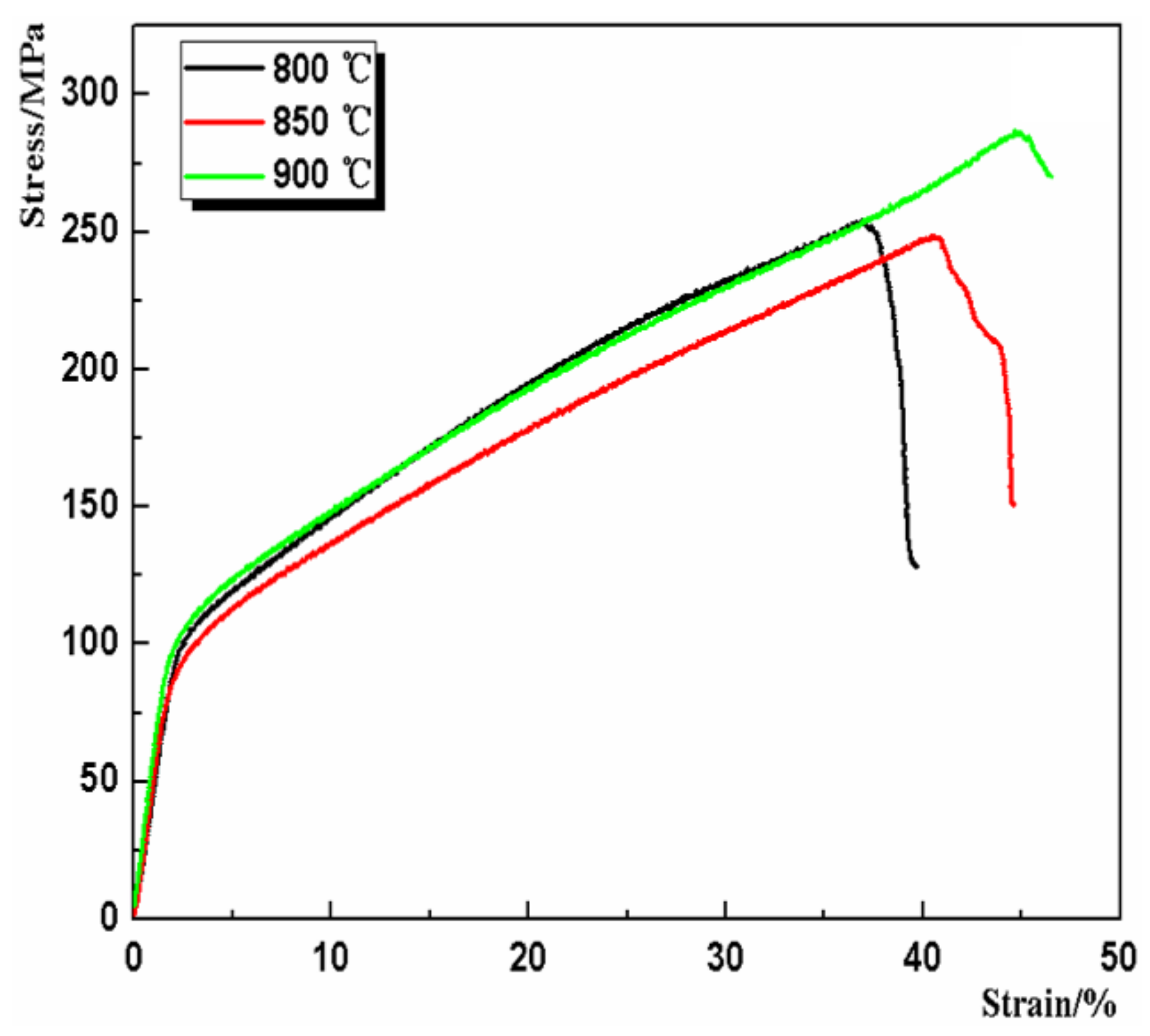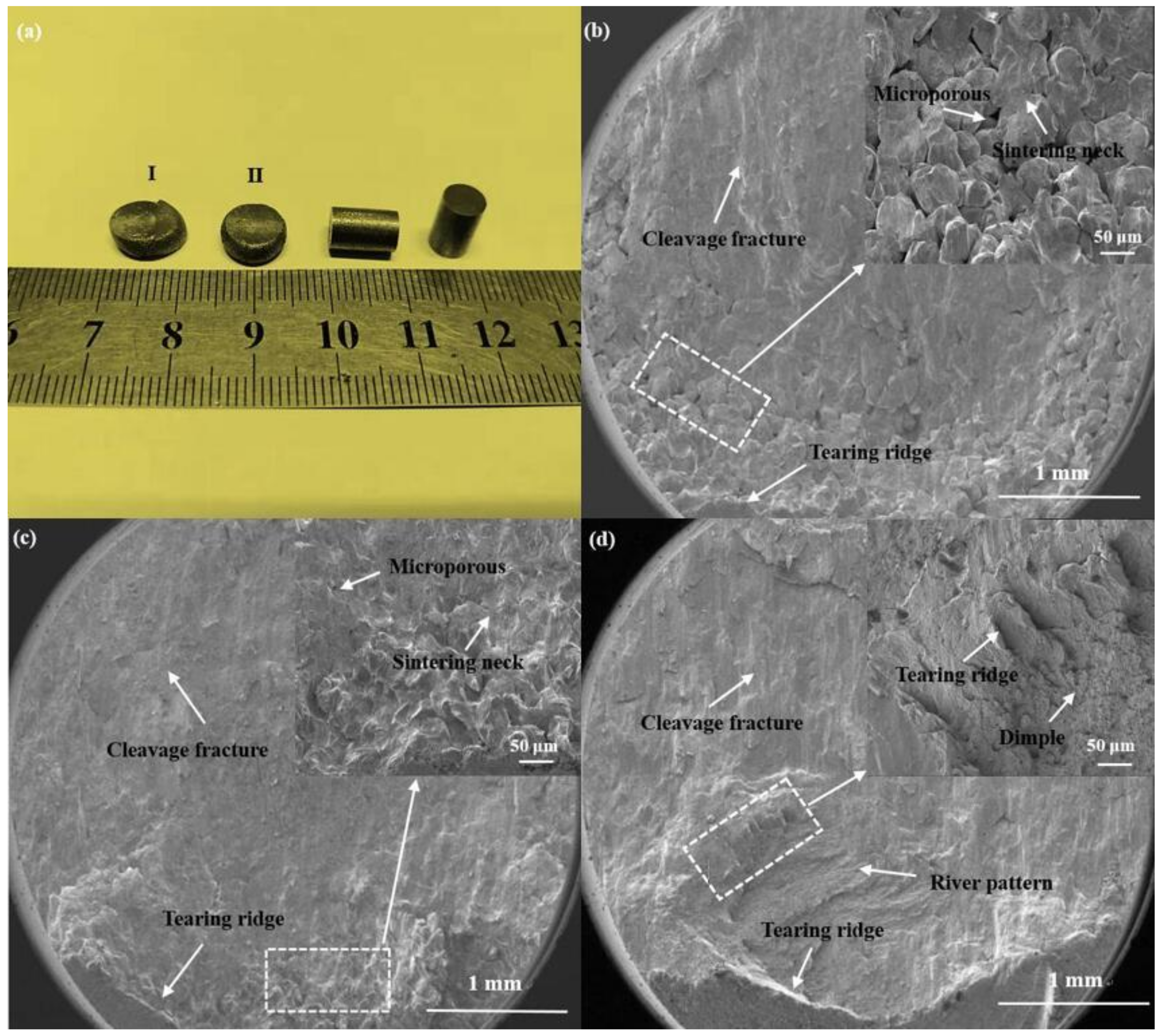Microstructure and Properties of Porous Titanium Prepared by Spark Plasma Sintering
Abstract
1. Introduction
2. Materials and Methods
2.1. Material
2.2. Preparation of Samples
2.3. Characterization
3. Results and Discussion
3.1. Phase Analysis
3.2. Microstructure and Pore Characteristic
3.3. Mechanical Properties
3.4. Compression Fracture Analysis
4. Conclusions
Author Contributions
Funding
Acknowledgments
Conflicts of Interest
References
- Prem, M.; Krexner, G.; Pleschiutschnig, J. Helium damage in long-aged metal–tritium systems. J. Alloys Compd. 2003, 356–357, 683–687. [Google Scholar] [CrossRef]
- Wang, P.; Song, J. Helium in Materials and the Permeation of Tritium; National Defense Industry Press: Beijing, China, 2002. [Google Scholar]
- Walters, R.T.; Nobile, A., Jr.; Mosley, W.C. Helium dynamics in metal tritides II. The significance of microstructure in the observed helium behavior for La Ni Al tritides. J. Less Common Met. 1991, 170, 63–74. [Google Scholar] [CrossRef]
- Shen, H.H.; Peng, S.M.; Long, X.G.; Xiang, X.; Zhou, X.S.; Yang, L.; Zu, X.T. Microstructure changes of erbium and erbium deuteride films induced by helium implantation. Mater. Lett. 2012, 80, 17–19. [Google Scholar] [CrossRef]
- Hirooka, Y.; Miyake, M.; Sano, T. A study of hydrogen absorption and desorption by titanium. J. Nucl. Mater. 1981, 96, 227–232. [Google Scholar] [CrossRef]
- Wu, Y.X.; Yang, R.; Zheng, H.; Wang, Y.M. First-principles study of alloying effect of transition metals on He in titanium ditritide. J. Nucl. Mater. 2006, 354, 36–48. [Google Scholar] [CrossRef]
- Wang, H.F.; Peng, S.M.; Zhou, X.S.; Cheng, G.J.; Wang, W.D.; Long, X.G.; Yang, B.F. Primarily Study on Thermodesorption From Titanium Tritide Films. At. Energy Sci. Technol. 2008, 42, 49–52. [Google Scholar]
- Hong-Chao, P.; Shun-Zhong, L.; Xing-Gui, L.; An, Z.; Ning, L.; Yan-Min, D.; Xing-Chun, W.; Ben-Fu, Y.; Pei-Lu, W.; Si-Xiao, Z. Effects of Substrate Temperature on Helium Content and Microstructure of Nanocrystalline Titanium Films. Chin. Phys. Lett. 2006, 23, 3238. [Google Scholar] [CrossRef]
- Chen, W.; Anselmi-Tamburini, U.; Garay, J.E.; Groza, J.R.; Munir, Z.A. Fundamental investigations on the spark plasma sintering/synthesis process: I. Effect of dc pulsing on reactivity. Mater. Sci. Eng. A 2005, 394, 139–148. [Google Scholar] [CrossRef]
- Liu, W.; An, R.; Wang, C.; Zheng, Z.; Tian, Y.; Xu, R.; Wang, Z. Recent Progress in Rapid Sintering of Nanosilver for Electronics Applications. Micromachines 2018, 9, 346. [Google Scholar] [CrossRef]
- Prasad, K.S.; Rao, A.; Bhardwaj, R.; Johri, K.K.; Chang, C.C.; Kuo, Y.K. Spark plasma sintering technique: An alternative method to enhance ZT values of Sb doped Cu2 SnSe3. J. Mater. Sci. Mater. Electron. 2018, 29, 13200–13208. [Google Scholar] [CrossRef]
- Shi, M.; Liu, S.; Wang, Q.; Yang, X.; Zhang, G. Preparation and Properties of Titanium Obtained by Spark Plasma Sintering of a Ti Powder–Fiber Mixture. Materials 2018, 11, 2510. [Google Scholar] [CrossRef] [PubMed]
- Shon, J.H.; Song, I.B.; Cho, K.S.; Park, Y.I.; Hong, J.K.; Park, N.K.; Oh, M.H. Effect of particle size distribution on microstructure and mechanical properties of spark-plasma-sintered titanium from CP-Ti powders. Int. J. Precis. Eng. Manuf. 2014, 15, 643–647. [Google Scholar] [CrossRef]
- Kozlík, J.; Becker, H.; Harcuba, P.; Stráský, J.; Janeček, M. Cryomilled and spark plasma sintered titanium: The evolution of microstructure. IOP Conf. Ser. Mater. Sci. Eng. 2017, 194, 012023. [Google Scholar] [CrossRef]
- Zheng, Y.; Wang, S.; You, M.; Tan, H.; Xiong, W. Fabrication of nanocomposite Ti(C,N)-based cermet by spark plasma sintering. Mater. Chem. Phys. 2005, 92, 64–70. [Google Scholar] [CrossRef]
- Zhang, L.; Zhang, Y.Q.; Jiang, Y.H.; Zhou, R. Mechanical behaviors of porous Ti with high porosity and large pore size prepared by one-step spark plasma sintering technique. Vacuum 2015, 122, 187–194. [Google Scholar] [CrossRef]
- Guo, Y.; Tan, Y.; Liu, Y.; Liu, S.; Zhou, R.; Tang, H. Low modulus and bioactive Ti/α-TCP/Ti-mesh composite prepared by spark plasma sintering. Mater. Sci. Eng. C 2017, 80, 197–206. [Google Scholar] [CrossRef] [PubMed]
- Miriyev, A.; Stern, A.; Tuval, E.; Kalabukhov, S.; Hooper, Z.; Frage, N. Titanium to steel joining by spark plasma sintering (SPS) technology. J. Mater. Process. Technol. 2013, 213, 161–166. [Google Scholar] [CrossRef]
- Nobuki, T.; Moriya, T.; Hatate, M.; Crivello, J.-C.; Cuevas, F.; Joubert, J.-M. Synthesis of TiFe Hydrogen Absorbing Alloys Prepared by Mechanical Alloying and SPS Treatment. Metals 2018, 8, 264. [Google Scholar] [CrossRef]
- Hidalgo, A.A.; Frykholm, R.; Ebel, T.; Pyczak, F. Powder Metallurgy Strategies to Improve Properties and Processing of Titanium Alloys: A Review. Adv. Eng. Mater. 2017, 19, 1600743. [Google Scholar] [CrossRef]
- Liu, N.; Li, Z.; Yuan, H.; Xu, W.; Zhang, Y.; Zhang, G. Fabrication and characterization of gas atomized TiAl alloy powder. J. Iron Steel Res. (Int.) 2011, s2, 537–540. [Google Scholar]
- Zhao, S.; Chen, G.; Tan, P.; Wang, J.; Liu, X. Characterization of spherical TC4 powders by gas atomization and its interstitial elemental control. Chin. J. Nonferrous Met. 2016, 26, 980–987. [Google Scholar]
- Popov, A.A.; Illarionov, A.G.; Stepanov, S.I.; Elkina, O.A.; Ivasishin, O.M. Effect of quenching temperature on structure and properties of titanium alloy: Structure and phase composition. Phys. Met. Metallogr. 2014, 115, 507–516. [Google Scholar] [CrossRef]
- Hernández-Nava, E.; Smith, C.J.; Derguti, F.; Tammas-Williams, S.; Leonard, F.; Withers, P.J.; Todd, I.; Goodall, R. The effect of defects on the mechanical response of Ti-6Al-4V cubic lattice structures fabricated by electron beam melting. Acta Mater. 2016, 108, 279–292. [Google Scholar] [CrossRef]
- Andrews, E.W.; Gibson, L.J.; Ashby, M.F. The creep of cellular solids. Acta Mater. 1999, 47, 2853–2863. [Google Scholar] [CrossRef]
- Griffith, A.A. The Phenomena of Rupture and Flow in Solids. Philos. Trans. R. Soc. Lond. 1921, 221, 163–198. [Google Scholar] [CrossRef]
- Peiyun, H. Principle of Powder Metallurgy; Metallurgical Industry Press: Beijing, China, 1982; pp. 1–390. [Google Scholar]





| Elements | C | N | H | O | Fe | Si | Al | Cl | Na | Ti |
|---|---|---|---|---|---|---|---|---|---|---|
| wt.% | 0.08 | 0.003 | 0.002 | 0.062 | 0.062 | 0.015 | 0.02 | <0.01 | <0.005 | Bal. |
| Sintering Temperature (°C) | Porosity (θ/%) | Yield Strength (σs/MPa) | Compressive Strength (σb/MPa) | Elastic Modulus (E/MPa) |
|---|---|---|---|---|
| 800 | 14.16 ± 1.35 | 100.56 ± 2.51 | 253.21 ± 3.82 | 3.23 ± 0.31 |
| 850 | 8.46 ± 0.57 | 94.37 ± 4.25 | 248.12 ± 7.49 | 2.97 ± 0.19 |
| 900 | 1.58 ± 0.24 | 112.58 ± 4.58 | 286.00 ± 14.0 | 3.74 ± 0.48 |
© 2019 by the authors. Licensee MDPI, Basel, Switzerland. This article is an open access article distributed under the terms and conditions of the Creative Commons Attribution (CC BY) license (http://creativecommons.org/licenses/by/4.0/).
Share and Cite
Liu, S.; Zhang, G.; Shi, M.; Yang, X.; Li, A. Microstructure and Properties of Porous Titanium Prepared by Spark Plasma Sintering. Metals 2019, 9, 82. https://doi.org/10.3390/met9010082
Liu S, Zhang G, Shi M, Yang X, Li A. Microstructure and Properties of Porous Titanium Prepared by Spark Plasma Sintering. Metals. 2019; 9(1):82. https://doi.org/10.3390/met9010082
Chicago/Turabian StyleLiu, Shifeng, Guangxi Zhang, Mingjun Shi, Xin Yang, and An Li. 2019. "Microstructure and Properties of Porous Titanium Prepared by Spark Plasma Sintering" Metals 9, no. 1: 82. https://doi.org/10.3390/met9010082
APA StyleLiu, S., Zhang, G., Shi, M., Yang, X., & Li, A. (2019). Microstructure and Properties of Porous Titanium Prepared by Spark Plasma Sintering. Metals, 9(1), 82. https://doi.org/10.3390/met9010082





